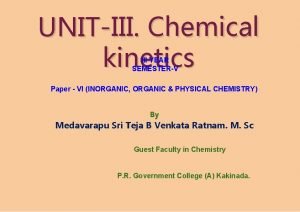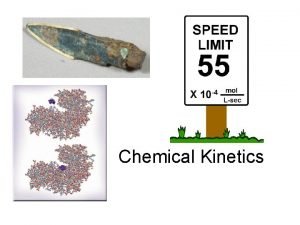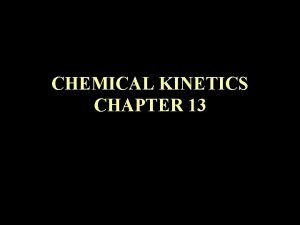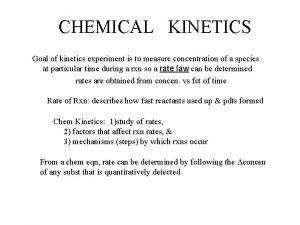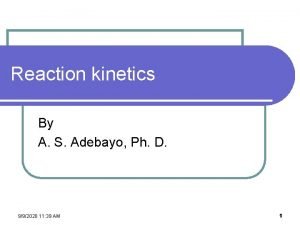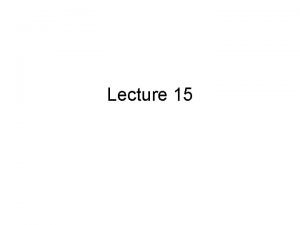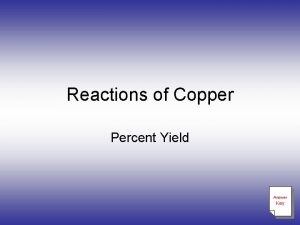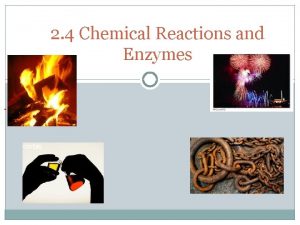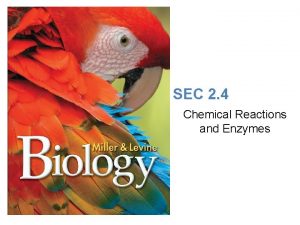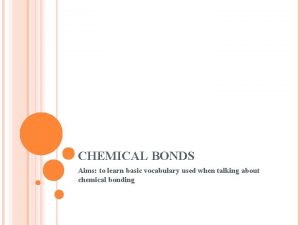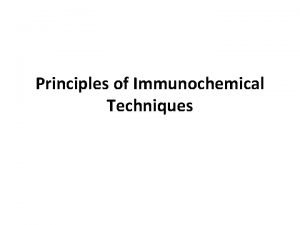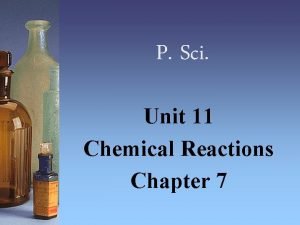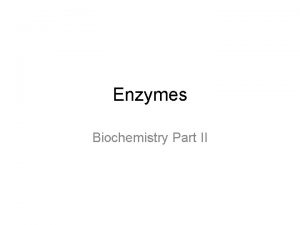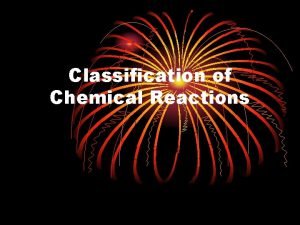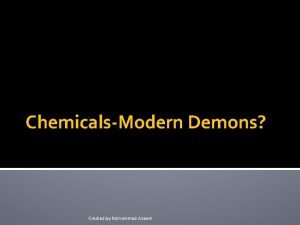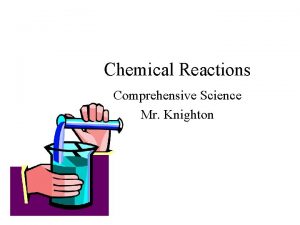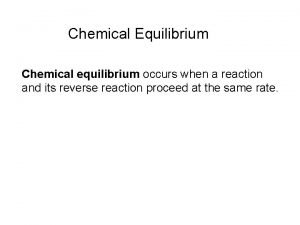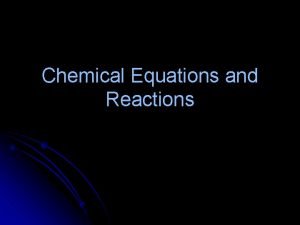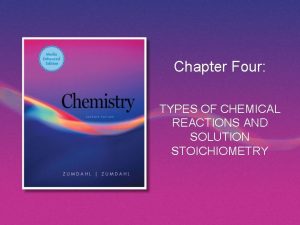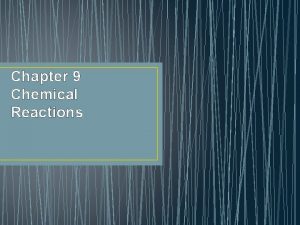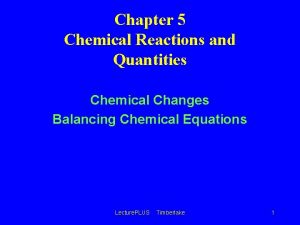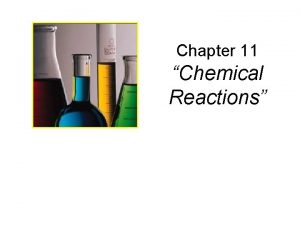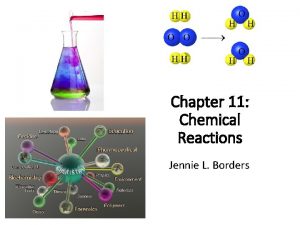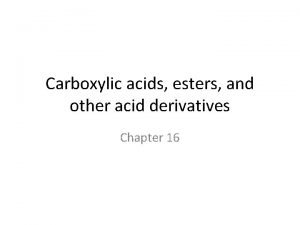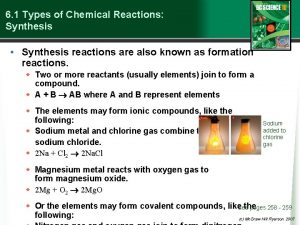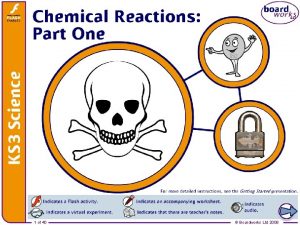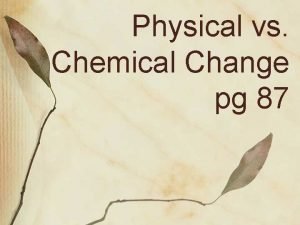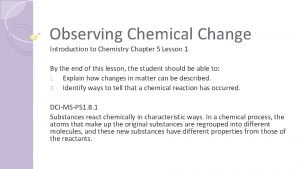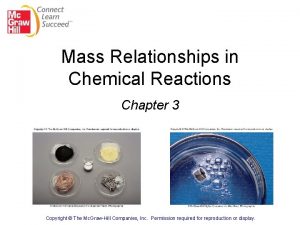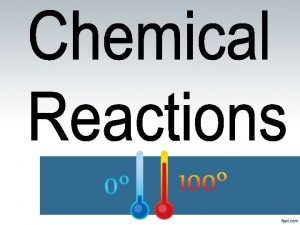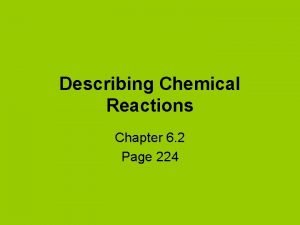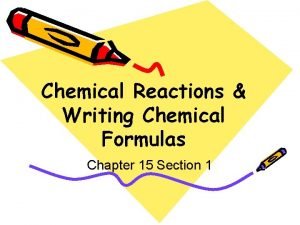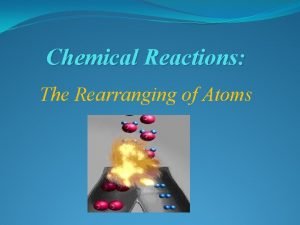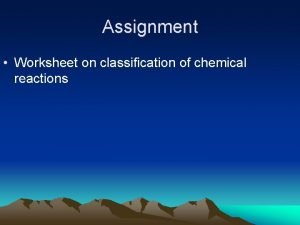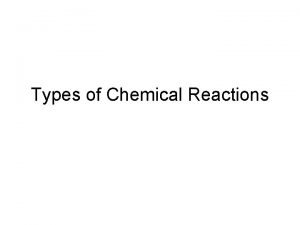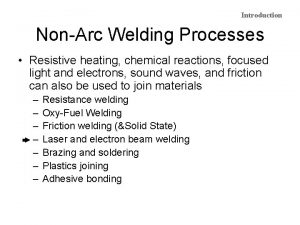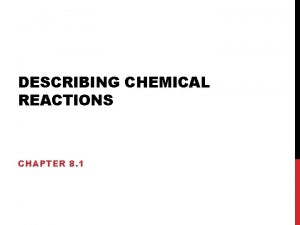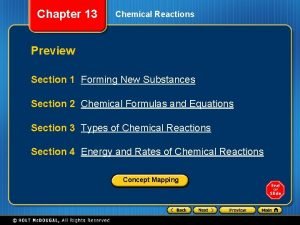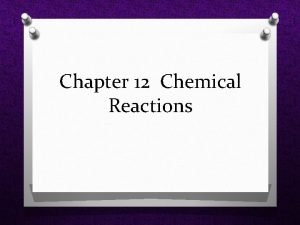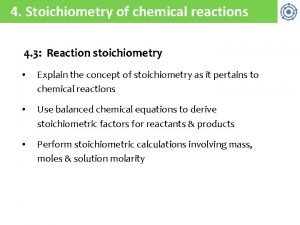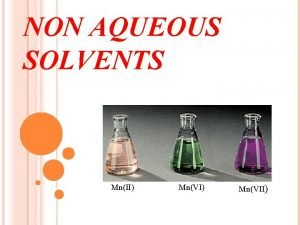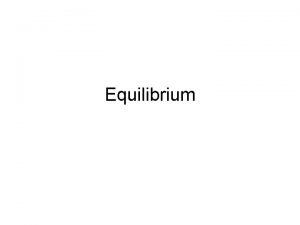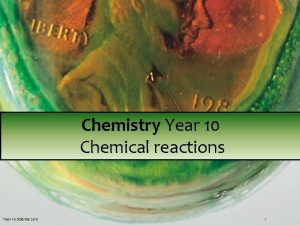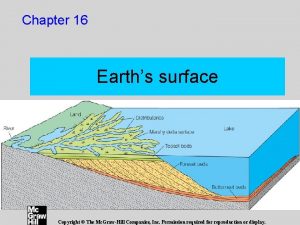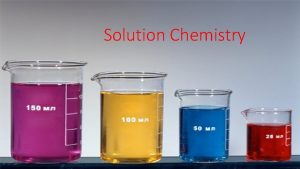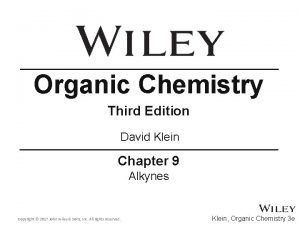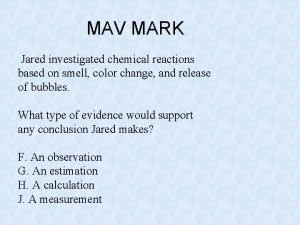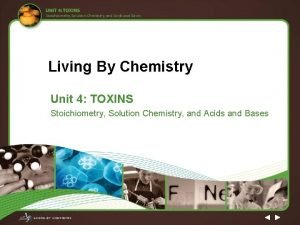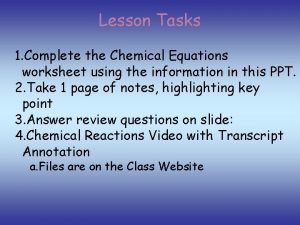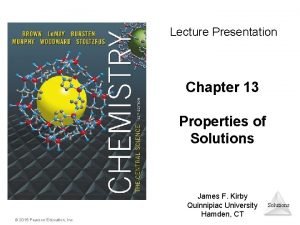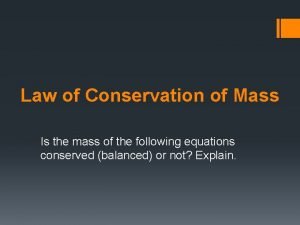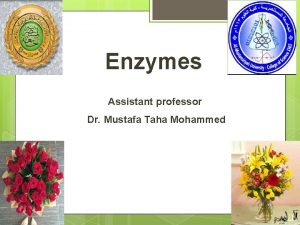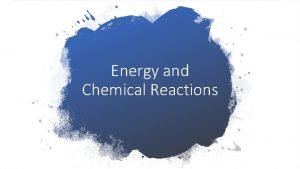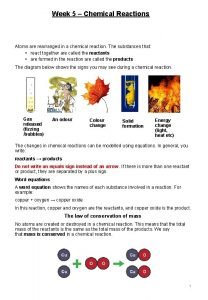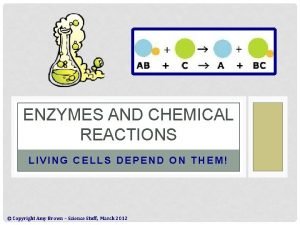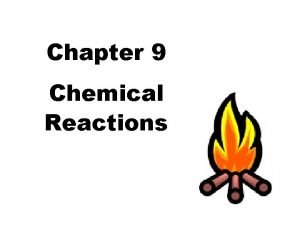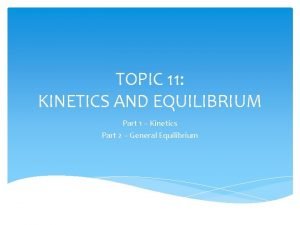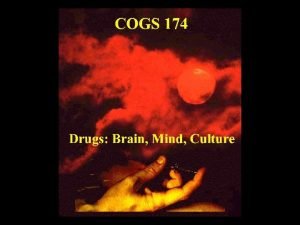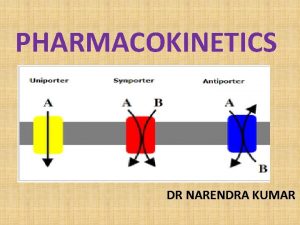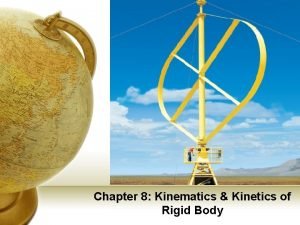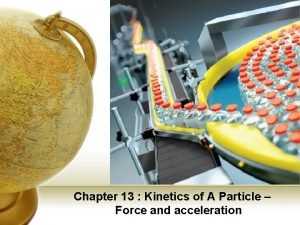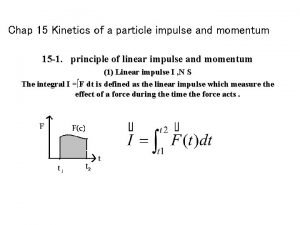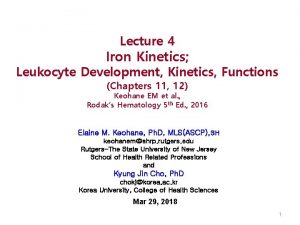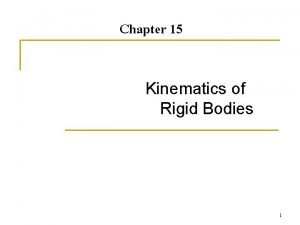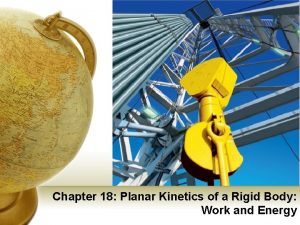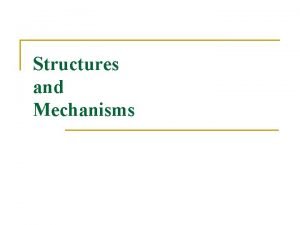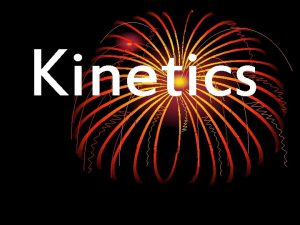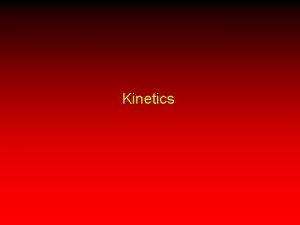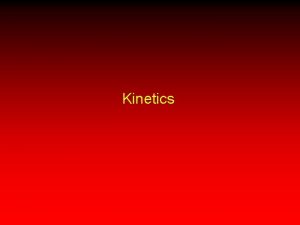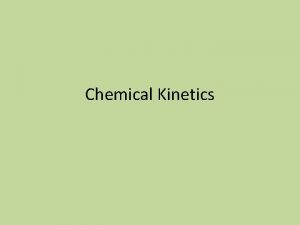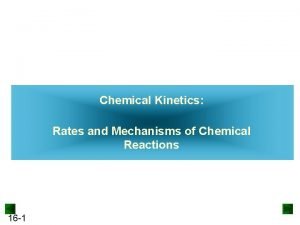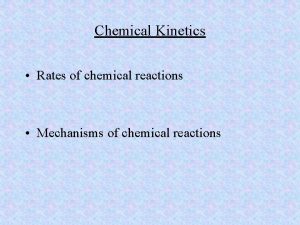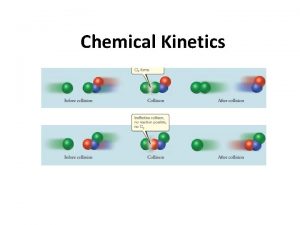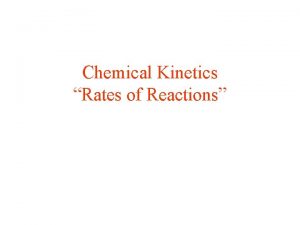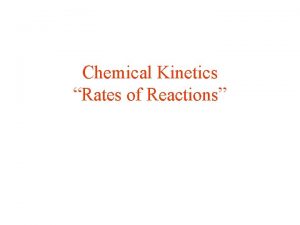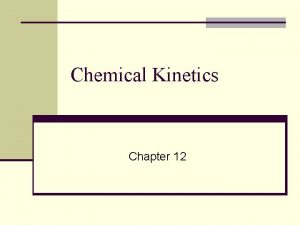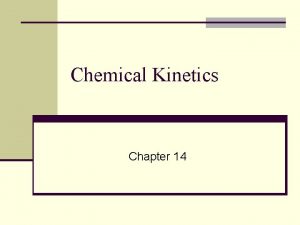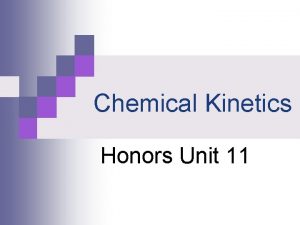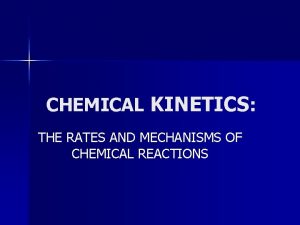Kinetics Rates and Mechanisms of Chemical Reactions Kinetics














![Figure 16. 6 A Plots of [reactant] and [product] vs. time. C 2 H Figure 16. 6 A Plots of [reactant] and [product] vs. time. C 2 H](https://slidetodoc.com/presentation_image_h/1b25001d20c9d497c2c821a952fb0f70/image-15.jpg)


![Figure 16. 7 Plots of reactant concentration, [A], vs. time for first-, second-, and Figure 16. 7 Plots of reactant concentration, [A], vs. time for first-, second-, and](https://slidetodoc.com/presentation_image_h/1b25001d20c9d497c2c821a952fb0f70/image-18.jpg)

![Sample Problem 16. 1 SOLUTION: (a) Rate = - [O 2] t 1 [H Sample Problem 16. 1 SOLUTION: (a) Rate = - [O 2] t 1 [H](https://slidetodoc.com/presentation_image_h/1b25001d20c9d497c2c821a952fb0f70/image-20.jpg)




























































![[NO 3] = k 1 [NO][O 2] k-1 rate 2 = k 2[NO 3][NO] [NO 3] = k 1 [NO][O 2] k-1 rate 2 = k 2[NO 3][NO]](https://slidetodoc.com/presentation_image_h/1b25001d20c9d497c2c821a952fb0f70/image-81.jpg)





































- Slides: 118

Kinetics: Rates and Mechanisms of Chemical Reactions

Kinetics: Rates and Mechanisms of Chemical Reactions Focusing on Reaction Rate Expressing the Reaction Rate The Rate Law and Its Components Integrated Rate Laws: Concentration Changes over Time Theories of Chemical Kinetics Catalysis: Speeding Up a Reaction






Expressing the Reaction Rate Reaction rate is measured in terms of the changes in concentrations of reactants or products per unit time. For the general reaction A → B, we measure the concentration of A at t 1 and at t 2: Rate = change in concentration of A change in time =- conc A 2 - conc A 1 t 2 - t 1 =- [A] t Square brackets indicate a concentration in moles per liter. The negative sign is used because the concentration of A is decreasing. This gives the rate a positive value.




Factors That Influence Reaction Rate • Particles must collide in order to react. • The higher the concentration of reactants, the greater the reaction rate. – A higher concentration of reactant particles allows a greater number of collisions. • The physical state of the reactants influences reaction rate. – Substances must mix in order for particles to collide. • The higher the temperature, the greater the reaction rate. – At higher temperatures particles have more energy and therefore collide more often and more effectively.

Table 16. 1 Time (s) Concentration of O 3 at Various Times in its Reaction with C 2 H 4 at 303 K Concentration of O 3 (mol/L) 0. 0 3. 20 x 10 -5 10. 0 2. 42 x 10 -5 20. 0 1. 95 x 10 -5 30. 0 1. 63 x 10 -5 40. 0 1. 40 x 10 -5 50. 0 1. 23 x 10 -5 60. 0 1. 10 x 10 -5 [C 2 H 4] rate = t [O 3] = t

Figure 16. 5 Three types of reaction rates for the reaction of O 3 and C 2 H 4.
![Figure 16 6 A Plots of reactant and product vs time C 2 H Figure 16. 6 A Plots of [reactant] and [product] vs. time. C 2 H](https://slidetodoc.com/presentation_image_h/1b25001d20c9d497c2c821a952fb0f70/image-15.jpg)
Figure 16. 6 A Plots of [reactant] and [product] vs. time. C 2 H 4 + O 3 → C 2 H 4 O + O 2 [O 2] increases just as fast as [C 2 H 4] decreases. Rate = = [C 2 H 4] t [C 2 H 4 O] t == [O 3] t [O 2] t

The Rate Law For any general reaction occurring at a fixed temperature a. A + b. B → c. C + d. D Rate = k[A]m[B]n The term k is the rate constant, which is specific for a given reaction at a given temperature. The exponents m and n are reaction orders and are determined by experiment. The values of m and n are not necessarily related in any way to the coefficients a and b.

Reaction Orders A reaction has an individual order “with respect to” or “in” each reactant. For the simple reaction A → products: If the rate doubles when [A] doubles, the rate depends on [A]1 and the reaction is first order with respect to A. If the rate quadruples when [A] doubles, the rate depends on [A]2 and the reaction is second order with respect to [A]. If the rate does not change when [A] doubles, the rate does not depend on [A], and the reaction is zero order with respect to A.
![Figure 16 7 Plots of reactant concentration A vs time for first second and Figure 16. 7 Plots of reactant concentration, [A], vs. time for first-, second-, and](https://slidetodoc.com/presentation_image_h/1b25001d20c9d497c2c821a952fb0f70/image-18.jpg)
Figure 16. 7 Plots of reactant concentration, [A], vs. time for first-, second-, and zero-order reactions.

Sample Problem 16. 1 Expressing Rate in Terms of Changes in Concentration with Time PROBLEM: Hydrogen gas has a nonpolluting combustion product (water vapor). It is used as a fuel abord the space shuttle and in earthbound cars with prototype engines: 2 H 2(g) + O 2(g) → 2 H 2 O(g) (a) Express the rate in terms of changes in [H 2], [O 2], and [H 2 O] with time. (b) When [O 2] is decreasing at 0. 23 mol/L·s, at what rate is [H 2 O] increasing? PLAN: We choose O 2 as the reference because its coefficient is 1. For every molecule of O 2 that disappears, two molecules of H 2 disappear, so the rate of [O 2] decrease is ½ the rate of [H 2] decrease. Similarly, the rate at which [O 2] decreases is ½ the rate at which [H 2 O] increases.
![Sample Problem 16 1 SOLUTION a Rate O 2 t 1 H Sample Problem 16. 1 SOLUTION: (a) Rate = - [O 2] t 1 [H](https://slidetodoc.com/presentation_image_h/1b25001d20c9d497c2c821a952fb0f70/image-20.jpg)
Sample Problem 16. 1 SOLUTION: (a) Rate = - [O 2] t 1 [H 2] = t 2 1 [H 2 O] = t 2 (b) Calculating the rate of change of [H 2 O]: [O 2] 1 [H 2 O] = t t 2 [H 2 O] t = -(-0. 23 mol/L·s) = 2(0. 23 mol/L·s) = 0. 46 mol/L·s

Figure 16. 9 Information sequence to determine the kinetic parameters of a reaction. Series of plots of concentration vs. time Initial rates Determine slope of tangent at t 0 for each plot. Compare initial rates when [A] changes and [B] is held constant (and vice versa). Reaction orders Rate constant (k) and actual rate law Substitute initial rates, orders, and concentrations into rate = k[A]m[B]n, and solve for k.





Table 16. 2 Initial Rates for the Reaction between A and B Initial Rate Experiment (mol/L·s) Initial [A] (mol/L) Initial [B] (mol/L) 1 1. 75 x 10 -3 2. 50 x 10 -2 3. 00 x 10 -2 2 3. 50 x 10 -3 5. 00 x 10 -2 3 3. 50 x 10 -3 2. 50 x 10 -2 6. 00 x 10 -2 4 7. 00 x 10 -3 5. 00 x 10 -2 6. 00 x 10 -2 [B] is kept constant for experiments 1 and 2, while [A] is doubled. Then [A] is kept constant while [B] is doubled.

Finding m, the order with respect to A: We compare experiments 1 and 2, where [B] is kept constant but [A] doubles: Rate 2 Rate 1 = k[A] m [B] n 2 k[A] m 1 2 [B] n 1 m = [A] 2 m [A]1 = [A]2 m [A]1 m 3. 50 x 10 -3 mol/L·s 1. 75 x 10 -3 mol/L·s = 5. 00 x 10 -2 mol/L 2. 50 x 10 -2 mol/L Dividing, we get 2. 00 = (2. 00)m so m = 1

Finding n, the order with respect to B: We compare experiments 3 and 1, where [A] is kept constant but [B] doubles: Rate 3 Rate 1 = k[A] m [B] n 3 k[A] m 1 3 [B] n 1 n = [B] 3 n [B]1 = [B]3 n [B]1 m 3. 50 x 10 -3 mol/L·s 1. 75 x 10 -3 mol/L·s = 6. 00 x 10 -2 mol/L 3. 00 x 10 -2 mol/L Dividing, we get 2. 00 = (2. 00)n so n = 1

Figure 16. 10 A Graphical method for finding the reaction order from the integrated rate law. First-order reaction integrated rate law ln [A]0 = - kt [A]t straight-line form ln[A]t = -kt + ln[A]0 A plot of ln [A] vs. time gives a straight line for a first-order reaction.

Figure 16. 10 B Graphical method for finding the reaction order from the integrated rate law. Second-order reaction integrated rate law 1 1 = kt [A]0 straight-line form 1 [A]t A plot of = kt + 1 [A]0 1 vs. time gives a straight line for a second-order reaction. [A]

Figure 16. 10 C Graphical method for finding the reaction order from the integrated rate law. Zero-order reaction integrated rate law [A]t - [A]0 = - kt straight-line form [A]t = - kt + [A]0 A plot of [A] vs. time gives a straight line for a first-order reaction.

Figure 16. 11 Graphical determination of the reaction order for the decomposition of N 2 O 5. The concentration data is used to construct three different plots. Since the plot of ln [N 2 O 5] vs. time gives a straight line, the reaction is first order.


Reaction Mechanism • Chemical equation: Summary • Mechanism: Series of elementary steps • Elementary Steps: Reactions with rate laws • from molecularity • Molecularity: Number of species that must collide to produce reaction

Intermediates – appear in steps – produced in one step – used in subsequent – not in overall equation

Rate-determining step • In a multi-step process: • SLOWEST step • Determines overall reaction rate

Determining Molecularity and Rate Laws for Elementary Steps PROBLEM: The following elementary steps are proposed for a reaction mechanism: (1) NO 2 Cl(g) → NO 2(g) + Cl(g) (2) NO 2 Cl(g) + Cl(g) → NO 2(g) + Cl 2(g) (a) (b) (c) Write the overall balanced equation. Determine the molecularity of each step. Write the rate law for each step. PLAN: We find the overall equation from the sum of the elementary steps. The molecularity of each step equals the total number of reactant particles. We write the rate law for each step using the molecularities as reaction orders.

Sample Problem 16. 10 SOLUTION: (a) Writing the overall balanced equation: (1) NO 2 Cl(g) → NO 2(g) + Cl(g) (2) NO 2 Cl(g) + Cl(g) → NO 2(g) + Cl 2(g) 2 NO 2 Cl(g) → 2 NO 2(g) + Cl 2(g) (b) Step(1) is unimolecular. Step(2) is bimolecular. (c) rate 1 = k 1[NO 2 Cl] rate 2 = k 2[NO 2 Cl][Cl]

The Rate-Determining Step of a Reaction The slowest step in a reaction is the rate-determining or rate-limiting step. The reaction NO 2(g) + CO(g) → NO(g) + CO 2(g) has been proposed to occur by a two-step mechanism: (1) NO 2(g) + NO 2(g) → NO 3(g) + NO(g) [slow; rate-determining] (2) NO 2(g) + CO(g) → NO 2(g) + CO 2(g) [fast] Observed rate law: rate = k[NO 2]2 The rate law for the rate-determining step becomes the rate law for the overall reaction.

Model for Kinetics • Collision Theory • rate determined by particle collisions • collision frequency and energy • Transition State Theory • how reactants convert to products

Collision Theory and Concentration The basic principle of collision theory is that particles must collide in order to react. An increase in the concentration of a reactant leads to a larger number of collisions, hence increasing reaction rate. The number of collisions depends on the product of the numbers of reactant particles, not their sum. Concentrations are multiplied in the rate law, not added.

Figure 16. 13 The number of possible collisions is the product, not the sum, of reactant concentrations. add another 6 collisions 4 collisions add another 9 collisions

Temperature and the Rate Constant Temperature has a dramatic effect on reaction rate. For many reactions, an increase of 10°C will double or triple the rate. Experimental data shows that k increases exponentially as T increases. This is expressed in the Arrhenius equation: k = rate constant A = frequency factor Ea = activation energy k = Ae-Ea/RT Higher T larger k increased rate

Figure 16. 14 Increase of the rate constant with temperature for the hydrolysis of an ester. Expt [Ester] [H 2 O] T (K) 1 2 3 4 0. 100 0. 200 288 298 308 318 Rate k (mol/L·s) (L/mol·s) 1. 04 x 10 -3 0. 0521 2. 20 x 10 -3 0101 3. 68 x 10 -3 0. 184 6. 64 x 10 -3 0. 332 Reaction rate and k increase exponentially as T increases.

Activation Energy In order to be effective, collisions between particles must exceed a certain energy threshold. When particles collide effectively, they reach an activated state. The energy difference between the reactants and the activated state is the activation energy (Ea) for the reaction. The lower the activation energy, the faster the reaction. Smaller Ea larger f larger k increased rate

Figure 16. 15 Energy-level diagram for a reaction. Collisions must occur with sufficient energy to reach an activated state. This particular reaction is reversible and is exothermic in the forward direction.

Figure 16. 21 Reaction energy diagrams and possible transition states for two reactions.

Figure 16. 22 Reaction energy diagram for the two-step reaction of (A) NO 2 and F 2 and of (B) NO and O 2. Each step in a multi-step reaction has its own transition state, which occurs at the energy maximum for that step.

Transition State Theory Ea and internal energy: Bonds breaking and forming Atoms rearranging “Transition State” Unstable intermediate At point of highest energy

forward reaction reverse reaction

I- + CH 3 Cl Cl- + CH 3 I

Temperature and Collision Energy An increase in temperature causes an increase in the kinetic energy of the particles. This leads to more frequent collisions and reaction rate increases. At a higher temperature, the fraction of collisions with sufficient energy equal to or greater than Ea increases. Reaction rate therefore increases.

Figure 16. 16 The effect of temperature on the distribution of collision energies.

Maxwell–Boltzmann Distributions Temperature is defined as a measure of the average kinetic energy of the molecules in a sample. • At any temperature there is a wide distribution of kinetic energies.

Maxwell–Boltzmann Distributions As the temperature increases, the curve flattens and broadens. Thus at higher temperatures, a larger population of molecules has higher energy.

Maxwell–Boltzmann Distributions If the dotted line represents the activation energy, as the temperature increases, so does the fraction of molecules that can overcome the activation energy barrier. • As a result, the reaction rate increases.

Maxwell–Boltzmann Distributions This fraction of molecules can be found through the expression: where R is the gas constant and T is the temperature in Kelvin.

Sample Problem 16. 9 Drawing Reaction Energy Diagrams and Transition States PROBLEM: A key reaction in the upper atmosphere is O 3(g) + O(g) → 2 O 2(g) The Ea(fwd) is 19 k. J, and the Hrxn for the reaction as written is -392 k. J. Draw a reaction energy diagram, predict a structure for the transition state, and calculate Ea(rev). PLAN: The reaction is highly exothermic ( Hrxn = -392 k. J), so the products are much lower in energy than the reactants. The small Ea(fwd) (19 k. J) means that the energy of the reactants lies only slightly below that of the transition state. We calculate the value of Ea(rev) from the value of H and Ea(fwd). To predict the transition state structure, we note that one O-O bond of O 3 breaks and a new O-O bond forms. 16 -58

Sample Problem 16. 9 SOLUTION: Hrxn = Ea(fwd) – Ea(rev) So Ea(rev) = + Ea(fwd) - Hrxn = 19 k. J – (-392 k. J) = 411 k. J Ea= 19 k. J transition state Ea(rev)= (392 + 19) k. J = Hrxn = -392 k. J 16 -59 411 k. J

Molecular Structure and Reaction Rate For a collision between particles to be effective, it must have both sufficient energy and the appropriate relative orientation between the reacting particles. The term A in the Arrhenius equation is the frequency factor for the reaction. k = Ae -Ea/RT A = p. Z p = orientation probability factor Z = collision frequency The term p is specific for each reaction and is related to the structural complexity of the reactants.

Collision Theory (Bimolecular Collsions) • Z: no. of bimolecular collisions per second • fa: fraction with Ea • P: fraction with correct orientation • Ea: activation energy





Arrhenius Equation Taking the natural logarithm of both sides, the equation becomes 1 RT y = mx + b When k is determined experimentally at several temperatures, Ea can be calculated from the slope of a plot of ln k vs. 1/T.

Arrhenius Equation k: E a: T: R: A: rate constant activation energy (minimum required) absolute temperature universal gas constant orientation factor Energy & orientation requirements for reaction







Table 16. 6 16 -74 The Effect of Ea and T on the Fraction (f) of Collisions with Sufficient Energy to Allow Reaction Ea (k. J/mol) f (at T = 298 K) 50 1. 70 x 10 -9 75 7. 03 x 10 -14 100 2. 90 x 10 -18 T f (at Ea = 50 k. J/mol) 25°C (298 K) 1. 70 x 10 -9 35°C (308 K) 3. 29 x 10 -9 45°C (318 K) 6. 12 x 10 -9

Calculating Activation Energy Ea can be calculated from the Arrhenius equation: k = Ae Ea 1 so ln k = ln A R T -Ea/RT straight-line form If data is available at two different temperatures: ln 16 -75 k 2 k 1 =- Ea R 1 1 − T 2 T 1

Sample Problem 16. 8 Determining the Energy of Activation PROBLEM: The decomposition of hydrogen iodide, 2 HI(g) → H 2(g) + I 2(g), has rate constants of 9. 51 x 10 -9 L/mol·s at 500. K and 1. 10 x 10 -5 L/mol·s at 600. K. Find Ea. PLAN: We are given two rate constants and two temperatures, so we can use the Arrhenius equation to solve for Ea. SOLUTION: E k ln 2 = - a k 1 R 1 1 − T 1 T 2 k so Ea = -R ln 2 k 1 1. 10 x 10 -5 L/mol·s ln Ea = -(8. 314 J/mol·K) 9. 51 x 10 -9 L/mol·s = 1. 76 x 105 J/mol = 1. 76 x 102 k. J/mol 16 -76 1 1 − T 1 T 2 1 1 − 600. K 500. K -1 -1

The Rate-Determining Step of a Reaction The slowest step in a reaction is the rate-determining or rate-limiting step. The reaction NO 2(g) + CO(g) → NO(g) + CO 2(g) has been proposed to occur by a two-step mechanism: (1) NO 2(g) + NO 2(g) → NO 3(g) + NO(g) [slow; rate-determining] (2) NO 2(g) + CO(g) → NO 2(g) + CO 2(g) [fast] Observed rate law: rate = k[NO 2]2 The rate law for the rate-determining step becomes the rate law for the overall reaction. 16 -77

Correlating Mechanism with the Rate Law A valid mechanism must meet three criteria: The elementary steps must add up to the overall balanced equation. The elementary steps must be reasonable. The mechanism must correlate with the observed rate law. A mechanism is a hypothesis –we cannot prove it is correct, but if it is consistent with the data, and can be used to predict results accurately, it is a useful model for the reaction. 16 -78

Mechanisms with a Slow Initial Step The overall reaction 2 NO 2(g) + F 2(g) → 2 NO 2 F(g) has an experimental rate law Rate = k[NO 2][F 2]. The accepted mechanism is (1) NO 2(g) + F 2(g) → NO 2 F(g) + F(g) [slow; rate determining] (2) NO 2(g) + F(g) → NO 2 F(g) [fast] 2 NO 2(g) + F 2(g) → 2 NO 2 F(g) The elementary steps sum to the overall balanced equation: Both steps are bimolecular and are therefore reasonable. rate 1 = k 1[NO 2[F 2] rate 2 = k 2[NO 2][F] Step 1 is the slow step, and rate 1 correlates with the observed rate law. The mechanism is therefore reasonable. 16 -79

Mechanisms with a Fast Initial Step The overall reaction 2 NO (g) + O 2(g) → 2 NO 2(g) has an experimental rate law Rate = k[NO]2[O 2]. A proposed mechanism is (1) NO(g) + O 2(g) D NO 3(g) [fast] (2) NO 3(g) + NO(g) → 2 NO 2(g) [slow; rate determining] 2 NO (g) + O 2(g) → 2 NO 2(g) The elementary steps sum to the overall balanced equation: Both steps are bimolecular and are therefore reasonable. rate 1(fwd) = k 1[NO][O 2] rate 1(rev) = k-1[NO 3] rate 2 = k 2[NO 3][NO] 16 -80 When equilibrium (1) has been established rate 1(fwd) = rate 1(rev) k 1[NO][O 2] = k-1[NO 3]
![NO 3 k 1 NOO 2 k1 rate 2 k 2NO 3NO [NO 3] = k 1 [NO][O 2] k-1 rate 2 = k 2[NO 3][NO]](https://slidetodoc.com/presentation_image_h/1b25001d20c9d497c2c821a952fb0f70/image-81.jpg)
[NO 3] = k 1 [NO][O 2] k-1 rate 2 = k 2[NO 3][NO] = k 2 k 1 [NO][O 2] [NO] k-1 The ratio of rate constants is itself a constant, equal to the overall rate constant for the reaction, so rate 2 = k[NO]2[O 2] which is consistent with the observed rate law. For any mechanism, only reactants involved up to and including the slow (rate-determining) step appear in the overall rate law. 16 -81

Figure 16. 22 Reaction energy diagram for the two-step reaction of (A) NO 2 and F 2 and of (B) NO and O 2. Each step in a multi-step reaction has its own transition state, which occurs at the energy maximum for that step. 16 -82


What is a Catalyst ? Catalyst is a substance that increases the rate of the reaction at which a chemical system approaches equilibrium , without being substantially consumed in the process. Catalyst affects only the rate of the reaction, i. e. Kinetics It changes neithermodynamics of the reaction nor the equilibrium composition. 84

Chemical Reaction Thermodynamics says NOTHING about the rate of a reaction. Thermodynamics : Will a reaction occur ? Kinetics : If so, how fast ? 85

Kinetic Vs. Thermodynamic A reaction may have a large, negative Grxn, but the rate may be so slow that there is no evidence of it occurring. Conversion of graphite to diamonds is a thermodynamic favor process ( G -ve ). C (graphite) �C (diamond) Kinetics makes this reaction nearly impossible (Requires a very high pressure and temperature over long time) 86

Kinetic Vs. Thermodynamic Reaction path for conversion of A + B into AB 87

Activation Energy : The energy required to overcome the reaction barrier. Usually given a symbol Ea or ∆G≠ The Activation Energy (Ea) determines how fast a reaction occurs, the higher Activation barrier, the slower the reaction rate. The lower the Activation barrier, the faster the reaction 88



CH 4003 Lecture Notes 11 (Erzeng Xue) Catalysis & Catalysts Action of Catalysts q Catalysis action - Reaction kinetics and mechanism Catalyst action leads to the rate of a reaction to change. This is realised by changing the course of reaction (compared to non-catalytic reaction) Forming complex with reactants/products, controlling the rate of elementary steps in the process. This is evidenced by the facts that uncatalytic Ø The reaction activation energy is altered Ø The intermediates formed are different from those formed in non-catalytic reaction Ø The catalytic energy m rates of reactions are altered (both desired and undesired ones) m reactant produc reaction processt Reactions proceed under less demanding conditions Ø Allow reactions occur under a milder conditions, e. g. at lower temperatures for those heat sensitive materials 91

Activation Energy This means , the catalyst changes the reaction path by lowering its activation energy and consequently the catalyst increases the rate of reaction. 92

Catalysis: Speeding up a Reaction A catalyst is a substance that increases the reaction rate without itself being consumed in the reaction. In general, a catalyst provides an alternative reaction pathway that has a lower total activation energy than the uncatalyzed reaction. A catalyst will speed up both the forward and the reverse reactions. A catalyst does not affect either H or the overall yield for a reaction.





CH 4003 Lecture Notes 11 (Erzeng Xue) Catalysis & Catalysts Types of Catalysts & Catalytic Reactions q The types of catalysts m Classification based on the its physical state, a catalyst can be Ø gas Ø liquid Ø solid m Classification based on the substances from which a catalyst is made Ø Inorganic Ø Organic m (gases, metal oxides, inorganic acids, bases etc. ) (organic acids, enzymes etc. ) Classification based on the ways catalysts work Ø Homogeneous - both catalyst and all reactants/products are in the same phase (gas or liq) Ø Heterogeneous - reaction system involves multi-phase (catalysts + reactants/products) m Classification based on the catalysts’ action Ø Acid-base catalysts Ø Enzymatic Ø Photocatalysis 98

Adsorption, activation, reaction, desorption


Figure The metal-catalyzed hydrogenation of ethene. A heterogeneous catalyst is in a different phase than the reaction mixture.

Figure 16. 24 The catalyzed decomposition of H 2 O 2. A homogeneous catalyst is in the same phase as the reaction mixture. A small amount of Na. Br is added to a solution of H 2 O 2. Oxygen gas forms quickly as Br-(aq) catalyzes the H 2 O 2 decomposition; the intermediate Br 2 turns the solution orange.

Figure 16. 26 A Two models of enzyme action. The lock-and-key model visualizes the enzyme active site having a fixed shape. This shape matches the shape of its substrate(s). The active site is therefore specific to its substrate.

Figure 16. 26 B Two models of enzyme action. The induced-fit model visualizes the enzyme active site changing shape in order to bind its substrate(s) more effectively. The active site is still selective towards certain substrates.






Dynamic (Catalytic) Properties of Catalysts: Definitions and Specifications.



CH 4003 Lecture Notes 12 (Erzeng Xue) Catalysis & Catalysts q Catalytic Reaction Processes General requirements for a good catalyst m Activity - being able to promote the rate of desired reactions m Selective - being to promote only the rate of desired reaction and also retard the undesired reactions Note: The selectivity is sometime considered to be more important than the activity and sometime it is more difficult to achieve SO 2) m (e. g. selective oxidation of NO to NO 2 in the presence of Stability - a good catalyst should resist to deactivation, caused by è the presence of impurities in feed (e. g. lead in petrol poison TWC. è thermal deterioration, volatility and hydrolysis of active components è attrition due to mechanical movement or pressure shock 11 3

CH 4003 Lecture Notes 12 (Erzeng Xue) Catalysis & Catalysts Solid Catalysts q Some common solid support / carrier materials m m Alumina Inexpensive Ø Surface area: 1 ~ 700 m 2/g Ø Acidic Other supports Ø Ø m Silica Inexpensive Ø Surface area: 100 ~ 800 m 2/g Ø Acidic Ø m Ø Ø Zeolite mixture of alumina and silica, Ø often exchanged metal ion present Ø shape selective Ø acidic Ø Active carbon (S. A. up to 1000 m 2/g) Titania (S. A. 10 ~ 50 m 2/g) Zirconia (S. A. 10 ~ 100 m 2/g) Magnesia (S. A. 10 m 2/g) Lanthana (S. A. 10 m 2/g) Active site porous solid pore 11 4

11 5

CH 4003 Lecture Notes 13 (Erzeng Xue) Catalysis & Catalysts Adsorption On Solid Surface q Applications of adsorption process m Adsorption is a very important step in solid catalysed reaction processes m Adsorption in itself is a common process used in industry for various purposes Ø Purification (removing impurities from a gas / liquid stream) Ø De-pollution, Ø Solvent de-colour, de-odour recovery, trace compound enrichment Ø etc… Ø Usually adsorption is only applied for a process dealing with small capacity Ø The operation is usually batch type and required regeneration of saturated adsorbent Common adsorbents: molecular sieve, active carbon, silica gel, activated alumina. m Physisorption is an useful technique for determining the surface area, the pore shape, pore sizes and size distribution of porous solid materials (BET surface area) 11 6

CH 4003 Lecture Notes 11 (Erzeng Xue) Catalysis & Catalysts q Applications of Catalysis Industrial applications Almost all chemical industries have one or more steps employing catalysts m Petroleum, energy sector, fertiliser, pharmaceutical, fine chemicals … Advantages of catalytic processes m Achieving better process economics and productivity Ø Increase reaction rates - fast Ø Simplify the reaction steps - low investment cost Ø Carry out reaction under mild conditions (e. g. low T, P) - low energy consumption m Reducing wastes Ø Improving selectivity toward desired products - less raw materials required, less unwanted wastes Ø Replacing harmful/toxic materials with readily available ones m Producing certain products that may not be possible without catalysts m Having better control of process (safety, flexible etc. ) m Encouraging application and advancement of new technologies and materials m And many more … 11 7

CH 4003 Lecture Notes 11 (Erzeng Xue) Catalysis & Catalysts q Applications of Catalysis Environmental applications m Pollution controls in combination with industrial processes Ø Pre-treatment - reduce the amount waste/change the composition of emissions Ø Post-treatments Ø Using - once formed, reduce and convert emissions alternative materials … m Pollution reduction Ø gas - converting harmful gases to non-harmful ones Ø liquid Ø solid - de-pollution, de-odder, de-colour etc - landfill, factory wastes … m q And many more … Other applications m Catalysis and catalysts play one of the key roles in new technology development. 11 8
 Chemical reactions section 2 classifying chemical reactions
Chemical reactions section 2 classifying chemical reactions Section 2 reinforcement classifying chemical reactions
Section 2 reinforcement classifying chemical reactions Types of reactions
Types of reactions Section 1 chemical changes
Section 1 chemical changes Are kc and kp equal
Are kc and kp equal Unit rate vocabulary
Unit rate vocabulary Ratios guided notes
Ratios guided notes Ratios rates and unit rates
Ratios rates and unit rates Ratios rates and unit rates
Ratios rates and unit rates How to write half reactions
How to write half reactions Chemistry unit 5 reactions balancing reactions worksheet
Chemistry unit 5 reactions balancing reactions worksheet Molecularity of reaction
Molecularity of reaction Chemical reactions grade 11
Chemical reactions grade 11 Order of kinetics
Order of kinetics Chemical kinetics definition
Chemical kinetics definition Chemical kinetics experiment
Chemical kinetics experiment Applications of chemical kinetics
Applications of chemical kinetics What is steady state kinetics
What is steady state kinetics Chemical reactions reactants and products
Chemical reactions reactants and products Chemical equations and reactions chapter 8 review
Chemical equations and reactions chapter 8 review Chapter 8 section 1 chemical equations and reactions
Chapter 8 section 1 chemical equations and reactions Chemical equations and reactions chapter 8 review
Chemical equations and reactions chapter 8 review Section 2-4 chemical reactions and enzymes
Section 2-4 chemical reactions and enzymes I intro
I intro Types of chemical reactions and solution stoichiometry
Types of chemical reactions and solution stoichiometry Unit 5 chemical equations and reactions
Unit 5 chemical equations and reactions Types of chemical reactions and solution stoichiometry
Types of chemical reactions and solution stoichiometry Answer key
Answer key Section 2-4 chemical reactions and enzymes
Section 2-4 chemical reactions and enzymes Section 2-4 chemical reactions and enzymes
Section 2-4 chemical reactions and enzymes Chemical bond vocabulary
Chemical bond vocabulary Stoichiometry mole island diagram
Stoichiometry mole island diagram Types of chemical reactions redox
Types of chemical reactions redox Types of reactions
Types of reactions 4 types of chemical reactions
4 types of chemical reactions 5 types of chemical reactions
5 types of chemical reactions Predicting products of chemical reactions
Predicting products of chemical reactions 4 types of chemical reactions
4 types of chemical reactions Non examples of chemical reactions
Non examples of chemical reactions Chapter 10 chemical reactions answer key
Chapter 10 chemical reactions answer key The calculation of quantities in chemical equations
The calculation of quantities in chemical equations Ouchterlony
Ouchterlony Predicting products of chemical reactions
Predicting products of chemical reactions Predicting synthesis reactions
Predicting synthesis reactions Activity series of metals
Activity series of metals Unit 11 chemical reactions
Unit 11 chemical reactions Unit 4: toxins lesson 73 worksheet answers
Unit 4: toxins lesson 73 worksheet answers Four types of chemical reactions
Four types of chemical reactions What is the role of enzymes in chemical reactions
What is the role of enzymes in chemical reactions Describing chemical reactions
Describing chemical reactions Chemical reactions classification
Chemical reactions classification Chemical reactions in everyday life
Chemical reactions in everyday life What are five chemical changes
What are five chemical changes 5 general types of chemical reactions
5 general types of chemical reactions Solubility rules
Solubility rules Chapter 9 chemical reactions
Chapter 9 chemical reactions Equilibrium occurs when
Equilibrium occurs when Chapter 9 chemical reactions
Chapter 9 chemical reactions What are the 4 types of chemical reactions
What are the 4 types of chemical reactions Four types of chemical reactions
Four types of chemical reactions Chemical reactions chapter 9 study guide
Chemical reactions chapter 9 study guide 5 chemical reactions
5 chemical reactions 5 type of reactions
5 type of reactions Chapter 11 chemical reactions answer key
Chapter 11 chemical reactions answer key Predict the products of the following reactions.
Predict the products of the following reactions. Nomenclature
Nomenclature Summary of chemical reactions
Summary of chemical reactions Bread chemical reaction
Bread chemical reaction Solvent in chemical reactions
Solvent in chemical reactions Fatoumata dembele chef
Fatoumata dembele chef Mass relationships in chemical reactions
Mass relationships in chemical reactions Indications of a chemical reaction
Indications of a chemical reaction Describing chemical reactions
Describing chemical reactions Reaction rules
Reaction rules In a chemical reaction... atoms aren't rearranged
In a chemical reaction... atoms aren't rearranged Chapter 19 chemical reactions simple word equations
Chapter 19 chemical reactions simple word equations Classification of chemical reactions worksheet
Classification of chemical reactions worksheet What are the five general types of chemical reactions
What are the five general types of chemical reactions Laser beam welding (lbw)
Laser beam welding (lbw) Describing chemical reactions
Describing chemical reactions Section 1 atoms elements and compounds
Section 1 atoms elements and compounds Chapter 6 chemistry in biology
Chapter 6 chemistry in biology Section 2 chemical reactions answer key
Section 2 chemical reactions answer key Understanding chemical reactions worksheet answer key
Understanding chemical reactions worksheet answer key Stoichiometry map for chemical reactions
Stoichiometry map for chemical reactions What macromolecule is this
What macromolecule is this Classify the non aqueous solvents
Classify the non aqueous solvents Are all chemical reactions reversible
Are all chemical reactions reversible Chemical reactions in water
Chemical reactions in water Solvent in chemical reactions
Solvent in chemical reactions Chemical reactions in soil
Chemical reactions in soil Solvent in chemical reactions
Solvent in chemical reactions Solvent in chemical reactions
Solvent in chemical reactions Alkyne
Alkyne Jared investigated chemical reactions
Jared investigated chemical reactions Toxic reactions chemical equations
Toxic reactions chemical equations Chemical equations worksheet
Chemical equations worksheet Solvent in chemical reactions
Solvent in chemical reactions The law of conservation of mass
The law of conservation of mass Chemical reactions that release energy are called
Chemical reactions that release energy are called Type of chemical reactions
Type of chemical reactions In chemical reactions atoms are rearranged
In chemical reactions atoms are rearranged Difference between enzyme and protein
Difference between enzyme and protein Indications of chemical reactions
Indications of chemical reactions What are active metals
What are active metals Chapter 7 review chemical formulas and chemical compounds
Chapter 7 review chemical formulas and chemical compounds 7-3 practice problems chemistry answers
7-3 practice problems chemistry answers Kinetics and equilibrium
Kinetics and equilibrium Antagonistic effect
Antagonistic effect Zero order kinetics
Zero order kinetics Planar kinetics of a rigid body: force and acceleration
Planar kinetics of a rigid body: force and acceleration Kinetics of a particle: force and acceleration
Kinetics of a particle: force and acceleration Kinetics of a particle: impulse and momentum
Kinetics of a particle: impulse and momentum Prolymphocyte
Prolymphocyte Planar kinematics of a rigid body
Planar kinematics of a rigid body Planar kinetics of a rigid body work and energy
Planar kinetics of a rigid body work and energy Cell kinetics and fermenter design
Cell kinetics and fermenter design Virtualization structures tools and mechanisms
Virtualization structures tools and mechanisms Structures and mechanisms
Structures and mechanisms











